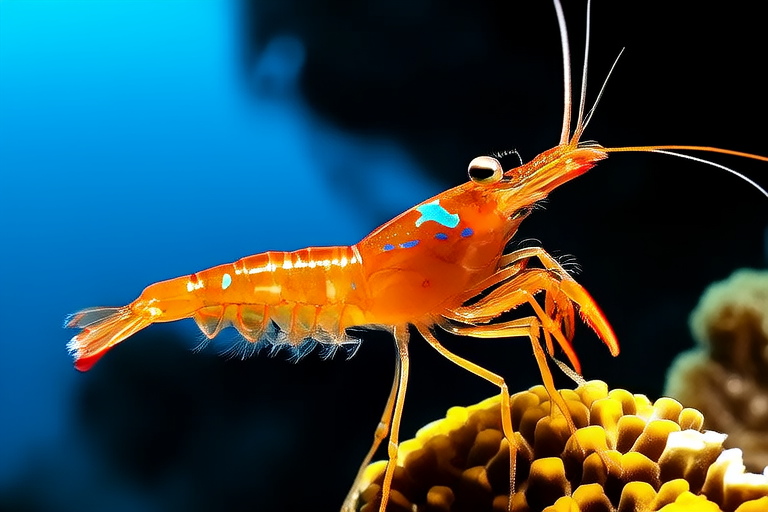The Role of Coral Shrimp in Aquatic Ecosystems
Coral shrimp play a vital role in maintaining the health and balance of aquatic ecosystems. These tiny crustaceans, scientifically known as Stenopus hispidus, are popular additions to saltwater aquariums due to their unique appearance and beneficial cleaning behavior. This article delves into the world of coral shrimp, exploring their role as clean-up crew members, their appearance, behavior, dietary habits, care requirements in home aquariums, and their significance to marine life.
Appearance and Identification
Coral shrimp are easily recognizable with their distinct red and white striped bodies and long, slender antennae. Their vibrant coloration serves as both camouflage and a warning to potential predators. These shrimp grow to an average length of about 3 inches (7.6 cm), making them small yet striking additions to any tank. Their bodies are covered with short spines that help protect them from larger fish and other threats in their environment. The males and females have subtle differences, with males typically having longer claws than females.
Dietary Habits
Coral shrimp are primarily scavengers and detritivores, feeding on algae, organic debris, and small organisms like plankton. They also consume dead tissue from fish and corals, helping to prevent the spread of disease. In the wild, these shrimp can be found in reef environments, where they play a crucial role in keeping the ecosystem clean. Their diet is diverse, allowing them to adapt to various food sources available in their habitat. In captivity, it is essential to provide them with a varied diet to ensure optimal health and longevity.
Behavior and Social Structure
Coral shrimp are generally peaceful creatures, but they can become territorial when space is limited or during mating season. They prefer to live in pairs or small groups, often forming close bonds with their tank mates. In the wild, they can be found hiding among coral branches or rocky crevices, emerging only to feed or explore their surroundings. When kept in home aquariums, providing ample hiding spots and ensuring sufficient space can help reduce aggression and stress among these shrimp. It is important to note that while coral shrimp are generally peaceful, they may exhibit territorial behavior towards other shrimp species, so careful consideration should be given when selecting tank mates.
Importance to Marine Life
In natural habitats, coral shrimp contribute significantly to the overall health of reefs by consuming harmful bacteria and fungi. By keeping surfaces clean, they promote the growth of healthy coral polyps and other marine organisms. Additionally, their presence helps maintain water quality by breaking down waste products and preventing the buildup of harmful substances. Coral shrimp also serve as prey for larger fish, playing an integral part in the food chain. Their role in maintaining the delicate balance of marine ecosystems cannot be overstated, as they help to ensure the survival of countless species that depend on healthy reef environments.
Care Requirements in Home Aquariums
When setting up a home aquarium for coral shrimp, it is essential to create an environment that mimics their natural habitat as closely as possible. A well-planted tank with plenty of hiding places, such as live rock and coral branches, will provide them with the security they need to thrive. Water parameters should be maintained at a pH level between 8.1 and 8.4, specific gravity of 1.023 to 1.025, and a temperature range of 72°F to 82°F (22°C to 28°C). Regular water changes and monitoring of water chemistry are crucial to ensure the health of your shrimp and other inhabitants.
Feeding coral shrimp in a home aquarium requires a balanced diet consisting of algae wafers, frozen foods like brine shrimp, and occasional supplements of vitamins and minerals. Providing a variety of food options will help ensure that your shrimp receive all the nutrients they need to stay healthy. It is also important to avoid overfeeding, as excess food can lead to poor water quality and negatively impact the overall health of your aquarium.
Practical Advice for Aquarists
For aquarists looking to add coral shrimp to their tanks, there are several key considerations to keep in mind:
- Compatibility: Choose tank mates carefully, avoiding aggressive or predatory species that may harm the shrimp. Peaceful fish like clownfish, tangs, and wrasses make excellent companions.
- Hiding Spots: Provide ample hiding spots and areas for the shrimp to feel secure. Live rock and coral branches are ideal for creating a natural environment.
- Water Quality: Maintain optimal water conditions through regular testing and water changes. Poor water quality can stress the shrimp and lead to health issues.
- Feeding: Offer a varied diet and avoid overfeeding. Monitor the amount of food provided to prevent waste accumulation.
- Observation: Keep a close eye on your shrimp’s behavior and health. Any signs of stress or illness should be addressed promptly to prevent further complications.
By following these guidelines, aquarists can create a thriving environment for their coral shrimp, ensuring they remain active and healthy members of the tank community.
Conclusion
Coral shrimp are fascinating and beneficial additions to any saltwater aquarium. Their role as clean-up crew members, combined with their unique appearance and interesting behaviors, makes them a popular choice among hobbyists. Understanding their dietary needs, social preferences, and care requirements is essential for maintaining a healthy and balanced aquarium. By providing the right environment and attention, aquarists can enjoy the beauty and benefits of these remarkable creatures for years to come.
